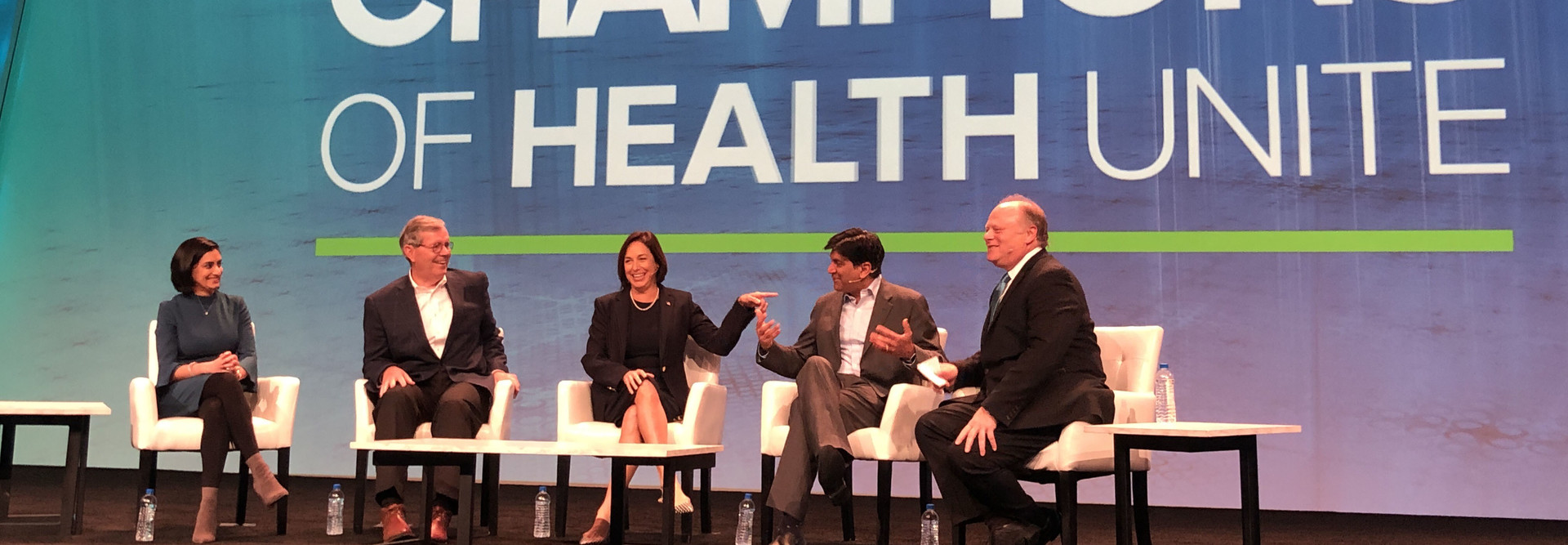HIMSS 2019: How Proposed Federal Rules Aim to Boost Patient Data Access
More and more, healthcare providers are leveraging technology to better meet patients on their terms, and patients are taking notice. In a survey published last summer by Black Book Market Research, for instance, more than 90 percent of responding patients said that they did not feel obligated to return to provider organizations that don’t provide a satisfactory digital experience.
That includes access to data, which a panel of experts — including former National Coordinator for Health IT Dr. Karen DeSalvo and former U.S. Chief Technology Officer Aneesh Chopra — discussed during Tuesday’s opening keynote session at HIMSS19 in Orlando, Fla. Also featuring Centers for Medicare & Medicaid Services Administrator Seema Verma, former Health and Human Services Secretary Michael Leavitt and HIMSS President and CEO Hal Wolf III, the conversation was driven largely by a long-awaited proposed rule published by the Office of the National Coordinator for Health IT on Monday focused on patient access to information and information blocking. In the rule, ONC proposes adopting the Fast Healthcare Interoperability Resource (FHIR) standards as “the standard to which developers must certify their APIs” as part of an effort to “support an ecosystem for the secure flow of information.”
MORE FROM HEALTHTECH: Check out all of our stories and videos from HIMSS19.
“We believe this approach could lead to industry standard interfaces — interfaces where app developers can develop effective apps that use API technology without special efforts to access a patient’s data,” current National Coordinator for Health IT Don Rucker says in a blog post about the rule.
At the keynote session, Verma said the rule will help patients to become better partners in their own care, and that it will help providers to have more complete information to make better decisions and improve safety. Leavitt agreed, calling the rule transformative for the industry.
“These rules now are basically saying ‘let’s use the power of consumers — let’s create APIs that people can submit information in a standardized way,’ and by doing that, we’ll see the power of consumerism reshape this,” he said.
Opening Up Data Pathways for Clinical Care and Innovation
DeSalvo, now a professor with the University of Texas at Austin Dell Medical School, said that opening up data pathways is not just about improving clinical care, but also making the industry as a whole more innovative and nimble.
“It’s about improving preparedness in public health; it’s about improving science and research. There are many ways that people want to use the data, and being able to free it, not just from the EHR, but from the many other places that it’s hoarded and held or blocked, was really a goal of ours during our time toward the end of the administration,” she said.
Added DeSalvo, “It’s an incredibly exciting time, because we’re not having a deep conversation about EHRs and how to unlock that data. We’re really talking about how to create the pull, how consumers are going to drive this marketplace and how we’re going to think every day about doing this on behalf of them.”
JOIN THE CONVERSATION: Follow @CDW_Healthcare on Twitter for continued HIMSS19 coverage.
‘The Plumbing Is All There’ for Better Connectivity, Data Flow
Chopra, who now serves as president of CareJourney, said that he’s bullish about the opportunity ahead.
“The way we structured the API rule under [DeSalvo’s] leadership was the notion that, philosophically, the consumer should have the ability to connect an app of their choice to their data,” he said. “Then the community did rise up and say ‘Why don’t we work together on a common language to make that reality?’ and so that’s where we are today.”
Now, Chopra said, every provider organization essentially has a “set-top box” — like a cable box — that enables consumer connectivity to retrieve data. “The plumbing is there, and that consumer app that you have in your hand, you can connect onto that set-top box,” he said. “But the only channel is the common clinical data set — PBS without Downton Abbey. We’re going to add, now, more content on the set-top box: discharge notifications, notes, images and a whole host of other clinically relevant information to move this along.”
Keep this page bookmarked for articles from the event. Follow us on Twitter @CDW_Healthcare, as well as the official organization account, @HIMSS, and join the conversation using hashtags including #CDWHIMSS and #HIMSS19.










